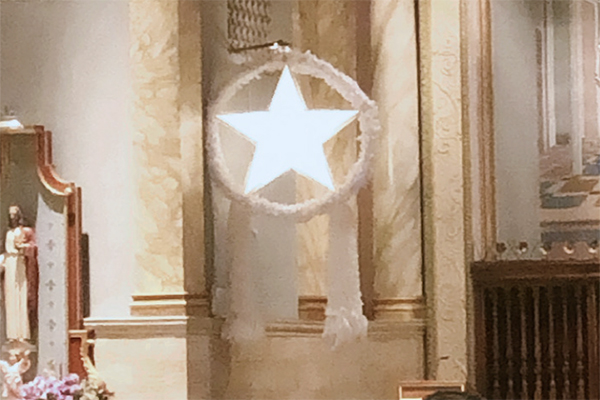
EAST ELMHURST — For Filipinos, the heart of the Christmas season is “Simbang Gabi,” or “Mass at Night ” — a nine-day novena of dawn or evening Masses that ends on Dec. 24.
The custom, which has roots in the Spanish Catholic Church, is sometimes called the “Misa de Gallo,” or “Rooster’s Mass.” It is celebrated at several parishes here in the Diocese of Brooklyn, including at St. Adalbert’s, East Elmhurst, where attending the novena is one way John Zambrona keeps his children closely connected to their Filipino Catholic roots.
Zambrona and his family, who moved to Queens from the Philippines in 2009, help organize the annual Simbang Gabi novena at St. Adalbert’s, which is one of a handful of churches in the diocese that has a monthly Mass in Tagalog, the national language of the Philippines.
“We want to pass on the tradition, and encourage the younger generation to put their faith into practice, in favor of Mother Mary,” Zambrona said.
“The belief is that when you complete the nine-day novena, your wish will come true. It’s such a beautiful activity and gathering of families, reminding us to practice our own faith daily, while honoring and remembering how we celebrate back home,” he said.
Now, his kids volunteer as ushers, altar servers and sacristans at the parish.
“I really love the songs, the music, the decorations, and the way [Simbang Gabi] brings people together,” said Zambrona’s son Joaquin, 14, who serves as an usher. “It really strengthens my faith, and helps me to clear my mind.”
At St. Sebastian, Woodside, Dee Bueno attends the Simbang Gabi Masses every year. He feels a sense of deep accomplishment after finishing all nine days.
“It’s motivation to wake up early and push yourself to go,” he said. “In spite of the busy and scrambling daily schedule, I still manage to attend and listen to the good news of our God.”
Father Mirek Podymniak, the pastor at St. Adalbert’s, said that immigrant communities should continue to bring their traditions to the church, because they show the diverse beauty of the faith and draw Catholics from other neighborhoods and parishes.
“We all have beautiful traditions and emphasis on different saints, but one common faith, one devotion. For Filipinos it’s the beautiful devotion to Mary,” Father Podymniak said. “I think Filipinos can teach Americans about devotion, because they are a good example of bringing their whole families to church.”
For Filipinos, the Christmas holiday season is indeed a deeply prayerful time of hope and goodwill to all.
Mechelle Gerona remembers getting up at the crack of dawn to attend Simbang Gabi Masses and later the Noche Buena Midnight Mass in her hometown of Bacolod City in the Philippines.
Gerona, who immigrated to New York in early 2018, said that Christmas is when she feels closest to her loved ones back home.
“For me, Simbang Gabi the best way to prepare in celebrating the birth of Christ, my personal sacrifice for Him. The [nine-day] novena is actually held to honor Mama Mary for carrying Jesus for nine months,” said Gerona, who attends St. Rose of Lima Roman Catholic Church in Kensington. “And it will never be completed without having a hot pandesal (bread) right after the Mass.”
Even when the prayers and festivities are over, Gerona said being with family during the holidays is what counts the most.
“As Christmas focuses on the family, that’s how important it is to celebrate with the people who are closest to our hearts,” she said. “The holiday season brings us together as a family, to remind us of the love of Christ and to share it with each other, and [it’s] the best time to heal broken relationships, as well.”

The Filipinos are a wonderful people. MALIGAYANG PASKO